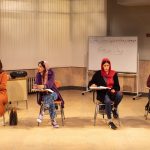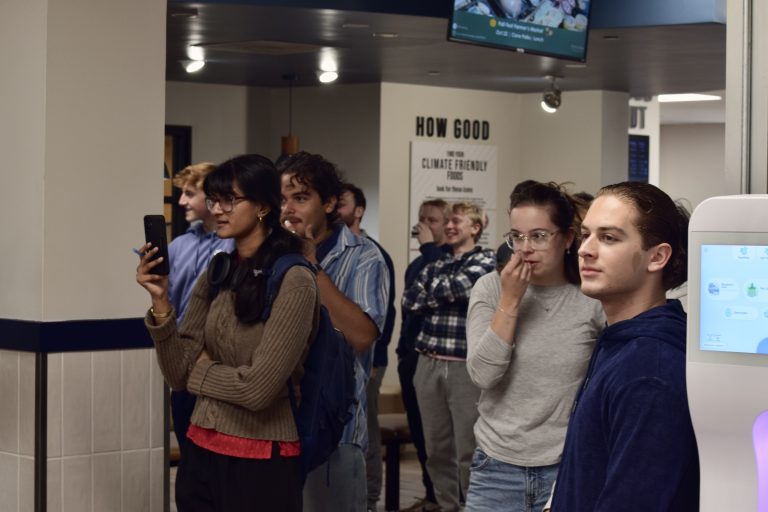Fields Thomas ’29
Staff Writer
In honor of TheatreWorks Hartford’s 40th anniversary, this season opens with a 2023 Pulitzer-winning show. “English,” written by Sanaz Toossi, brings a contemporary interpretation of Middle Eastern culture.
The show centers around five Farsi-speaking adults as they navigate learning English and the weight it carries. The play builds up to the TOEFL (Test of English as a Foreign Language), the English-speaking test they must pass to get green cards and passports. Throughout the production, the characters’ accents signal which language they’re speaking: an American accent represents Farsi while a Farsi accent represents English, a beautiful way to showcase two very complex languages. This switch allowed the audience to see the difference in stance, humor and even personality that happens when a person switches languages. In many ways, the show explores both the cultural and personal conflicts that come with learning a new language.
The play handles its themes with remarkable subtlety and beauty. “English” has a strong sense of self; its message is clear, and each crafted moment contributes meaningfully to it. The audience was deeply engaged by these beautiful moments. Often, when I see a play, I ask myself, “What was this made for?” or “Why did we need this?” Toossi already knew the answer. This show gracefully portrays sensitive subjects such as belonging and the political power of English and Iranian identity.
Toossi’s dialogue brings both playfulness and intention to scenes that could have easily become preachy or dull. The writing particularly shines through its characters — each one flawed, layered and purposeful. Every person in this cast feels important, their roles brought to life through precise dialogue and thoughtful acting.
The standout performance came from Anahita Monfared, who plays the young and spirited Goli. Monfared’s comedic timing had the audience laughing while preserving a soft spot for this incredibly likable character. Though Goli is as flawed as the others, Monfared’s portrayal invites empathy from the audience. Working with Toossi’s clever dialogue and her own improvisational energy, Monfared stood out among the ensemble. Her delivery was witty and physically interesting. From the opening scene, where she performed a presentation on an eyebrow pencil, she brought the audience in. Her energy had the audience always rooting for her in a sensitive and humorous way.
“English” struggled to maintain consistency in its pacing. The scenes are short, but the actors were either written or directed to take long pauses and indulge in moments of dramatic silence, which often caused the show to lose momentum. Some scenes are rich with plot and emotion, while others feel directionless. This imbalance is most noticeable in the final act, which feels stagnant and ends abruptly.
The pacing issues were exasperated by the sound design. Between scenes, the tender tone was often interrupted by blaring music. For instance, after a moving moment when a character reflects on the meaning of Farsi, the lights dim, the audience is silent and then, suddenly, loud music fills the room. While the cultural music had its place in certain transitions, it often distracted from the dialogue and disrupted the emotional rhythm of the play.
One of this production’s strongest elements was the costume design. Each costume was detailed and personal, adding depth to every character. Designed by K. Duffer, the costumes reflected age, time, gender and personality beautifully.
When the production fully embraced color and brightness, it truly shone. The characters were bright, as was their dialogue, and when the show committed to that energy, it was wonderful. However, the set design didn’t always match that spirit. The stage was often gray and bare, lacking any clear visual connection to either Iran or America. At one point, a window opened on stage, hinting at a glimpse of Iranian culture, but instead of a vibrant scene, we saw only a tan wall. Iranian culture is known to be colorful, and an opportunity to showcase the beauty of Iran’s rich connection to color and art was missed.
There’s no doubt that “English” is a wonderful play, but at times this production held itself back. The audience seemed to beg for it to take the next step, which is to show us the Iran the play so beautifully speaks about. The world within the script is rich and meaningful; we just wanted to see it fully realized in the set, direction and pacing.
Although its final push is still to come, “English” is absolutely worth seeing. It’s 100 minutes filled to the brim with endearing dialogue and characters you’ll fall in love with. Its grounding in reality only strengthens it, and its potential to grow is as powerful as the story it tells.












+ There are no comments
Add yours